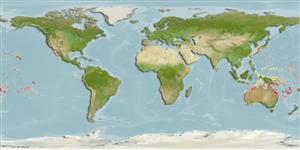Common names from other countries
>
Blenniiformes (Blennies) >
Tripterygiidae (Triplefin blennies) > Tripterygiinae
Etymology: Norfolkia: Named for the Norfolk Island ( In 1953 Henry W. Fowler named this new genus on a Collection of Fishes Made by Dr. Marshall Laird at Norfolk Island) (R.Bajol, pers.comm. 04/2016)..
More on author: Whitley.
Environment: milieu / climate zone / depth range / distribution range
Sinh thái học
Biển Cùng sống ở rạn san hô; Mức độ sâu 1 - 20 m (Ref. 13227). Tropical
Western Pacific: Western Australia in the eastern Indian Ocean to New Caledonia, Rapa, the Tuamoto Archipelago and Mangaréva.
Bộ gần gũi / Khối lượng (Trọng lượng) / Age
Maturity: Lm ? range ? - ? cm
Max length : 5.0 cm SL con đực/không giới tính; (Ref. 54980)
Short description
Hình thái học | Sinh trắc học
Các tia vây lưng cứng (tổng cộng): 18 - 19; Các vây lưng mềm (tổng cộng): 9-11; Tia cứng vây hậu môn 2; Tia mềm vây hậu môn: 20 - 22. Scales from head posteriorly to behind the eye but none on cheek; lobate supraorbital tentacle; body coloration white; yellow or orange on scale edges; 6 uneven, oblique, dark brown bands bifurcating ventrally; uneven brown bar below eye with white posterior border; females with thin, oblique, red and white bands on second and third dorsal fins; dull orange in males. Dorsal rays IV + XIV-XV + 9-11 (typically XV + 10); pectoral rays usually 15; lateral line discontinuous, 12-15 + 24-27; mandibular pores 3 + 2 + 3 (Ref. 54980).
Adults are found in coral reefs and intertidal pools (Ref. 13227). Eggs are hemispherical and covered with numerous sticky threads that anchor them in the algae on the nesting sites (Ref. 240). Larvae are planktonic which occur primarily in shallow, nearshore waters (Ref. 94114).
Life cycle and mating behavior
Chín muồi sinh dục | Sự tái sinh sản | Đẻ trứng | Các trứng | Sự sinh sản | Ấu trùng
Fricke, R., 1994. Tripterygiid fishes of Australia, New Zealand and the southwest Pacific Ocean (Teleostei). Theses Zool. 24:1-585. (Ref. 13227)
IUCN Red List Status (Ref. 130435)
CITES (Ref. 128078)
Not Evaluated
Threat to humans
Harmless
Human uses
Các nghề cá: không ích lợi (thú vị)
Thêm thông tin
Age/SizeSự sinh trưởngLength-weightLength-lengthLength-frequenciesSinh trắc họcHình thái họcẤu trùngSự biến động ấu trùngBổ xungSự phong phú
Các tài liệu tham khảoNuôi trồng thủy sảnTổng quan nuôi trồng thủy sảnCác giốngDi truyềnElectrophoresesDi sảnCác bệnhChế biếnMass conversion
Các công cụ
Special reports
Download XML
Các nguồn internet
Estimates based on models
Preferred temperature (Ref.
115969): 23.3 - 28.6, mean 26.6 (based on 778 cells).
Phylogenetic diversity index (Ref.
82804): PD
50 = 0.5625 [Uniqueness, from 0.5 = low to 2.0 = high].
Bayesian length-weight: a=0.00562 (0.00258 - 0.01228), b=3.08 (2.89 - 3.27), in cm Total Length, based on LWR estimates for this (Sub)family-body shape (Ref.
93245).
Mức dinh dưỡng (Ref.
69278): 3.2 ±0.4 se; based on size and trophs of closest relatives
Thích nghi nhanh (Ref.
120179): Chiêù cao, thời gian nhân đôi của chủng quần tối thiểu là dưới 15 tháng (Preliminary K or Fecundity.).
Fishing Vulnerability (Ref.
59153): Low vulnerability (10 of 100).
